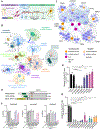Tip60-mediated H2A.Z acetylation promotes neuronal fate specification and bivalent gene activation
- PMID: 36417913
- PMCID: PMC9779922
- DOI: 10.1016/j.molcel.2022.11.002
Tip60-mediated H2A.Z acetylation promotes neuronal fate specification and bivalent gene activation
Abstract
Cell lineage specification is accomplished by a concerted action of chromatin remodeling and tissue-specific transcription factors. However, the mechanisms that induce and maintain appropriate lineage-specific gene expression remain elusive. Here, we used an unbiased proteomics approach to characterize chromatin regulators that mediate the induction of neuronal cell fate. We found that Tip60 acetyltransferase is essential to establish neuronal cell identity partly via acetylation of the histone variant H2A.Z. Despite its tight correlation with gene expression and active chromatin, loss of H2A.Z acetylation had little effect on chromatin accessibility or transcription. Instead, loss of Tip60 and acetyl-H2A.Z interfered with H3K4me3 deposition and activation of a unique subset of silent, lineage-restricted genes characterized by a bivalent chromatin configuration at their promoters. Altogether, our results illuminate the mechanisms underlying bivalent chromatin activation and reveal that H2A.Z acetylation regulates neuronal fate specification by establishing epigenetic competence for bivalent gene activation and cell lineage transition.
Keywords: Ascl1; H2A.Z acetylation; H3K4me3; Tip60/Kat5; bivalent chromatin; cell fate; gene activation; neurogenesis; reprogramming; transcription.
Copyright © 2022 Elsevier Inc. All rights reserved.
Conflict of interest statement
Declaration of interests The authors declare no competing interests.
Figures







References
Publication types
MeSH terms
Substances
Grants and funding
LinkOut - more resources
Full Text Sources
Molecular Biology Databases
Miscellaneous

